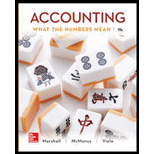
Accounting: What the Numbers Mean
11th Edition
ISBN: 9781259535314
Author: David Marshall, Wayne William McManus, Daniel Viele
Publisher: McGraw-Hill Education
expand_more
expand_more
format_list_bulleted
Concept explainers
Textbook Question
Chapter 5, Problem 5.31P
Problem 5.31
LO 7, 8
Cost flow assumptions-FIFO and LIFO using a periodic system Mower-Blower Sales Co. started business on January 20, 2016. Products sold were snow blowers and lawn mowers. Each product sold for $1,400. Purchases during 2016 were as follows:
| Blowers | Mowers | |
| January 21 | 20 @ $800 | |
| February 3 | 40 @ 780 | |
| February 28 | 30 @ 760 | |
| March 13 | 20 @ 760 | |
| April 6 | 20 @ $840 | |
| May 22 | 40 @ 860 | |
| June 3 | 40 @ 880 | |
| June 20 | 60 @ 920 | |
| August 15 | 20 @ 860 | |
| September 20 | 20 @ 840 | |
| November 7 | 20 @ 800 |
The December 31, 2016, inventory included 10 blowers and 25 mowers. Assume the company uses a periodic inventory system.
Required:
- What will be the difference between ending
inventory valuation at December 31, 2016, under the FIFO and LIFO cost flow assumptions? (Hint: Compute ending inventory under each method, and then compare results.) - If the cost of mowers had increased to $960 each by December 1, and if management had purchased 30 mowers at that time, which cost flow assumption was probably being used by the firm? Explain your answer.
Expert Solution & Answer
Want to see the full answer?
Check out a sample textbook solution
Students have asked these similar questions
I am looking for help with this general accounting question using proper accounting standards.
Depreciation is recorded in the books to:A. Increase asset valueB. Reflect fair market valueC. Allocate asset cost over timeD. Improve cash flow
correct sol
accounting question ?
Chapter 5 Solutions
Accounting: What the Numbers Mean
Ch. 5 - Prob. 5.1MECh. 5 - Prob. 5.2MECh. 5 - Mini-Exercise 5.3 LO 5 Accounts receivable, bad...Ch. 5 - Mini-Exercise 5.4 LO 5 Bad debts...Ch. 5 - Mini-Exercise 5.5 LO 7, 8 Cost flow...Ch. 5 - Mini-Exercise 5.6 LO 7, 8 Cost flow...Ch. 5 - Prob. 5.7ECh. 5 - Prob. 5.8ECh. 5 - Prob. 5.9ECh. 5 - Prob. 5.10E
Ch. 5 - Exercise 5.11 LO 5 Bad debts analysis-Allowance,...Ch. 5 - Exercise 5.12 LO 5 Bad debts analysis-Allowance...Ch. 5 - Exercise 5.13 LO 5 Cash discounts-ROI Annual...Ch. 5 - Prob. 5.14ECh. 5 - Exercise 5.15 LO 6 Notes receivable-interest...Ch. 5 - Exercise 5.16 LO 6 Notes receivable-interest...Ch. 5 - Exercise 5.17 LO 7, 8 LIFO versus FIFO-matching...Ch. 5 - Prob. 5.18ECh. 5 - Prob. 5.19ECh. 5 - Prob. 5.20ECh. 5 - Exercise 5.21 LO 5, 6, 8 Transaction...Ch. 5 - Exercise 5.22 LO 5. 8, 10 Transaction...Ch. 5 - Exercise 5.23 LO 5, 6, 7 Transaction...Ch. 5 - Exercise 5.24 LO 7, 8, 10 Transaction...Ch. 5 - Prob. 5.25PCh. 5 - Prob. 5.26PCh. 5 - Problem 5.27 LO 5 Bad debts analysis-Allowance...Ch. 5 - Problem 5.28 LO 5 Bad debts analysis-Allowance...Ch. 5 - Problem 5.29 LO 5 Analysis of accounts receivable...Ch. 5 - Problem 5.30 LO 5 Analysis of accounts receivable...Ch. 5 - Problem 5.31 LO 7, 8 Cost flow assumptions-FIFO...Ch. 5 - Problem 5.32 LO 7, 8 Cost flow assumptions-FIFO,...Ch. 5 - Prob. 5.33PCh. 5 - Prob. 5.34PCh. 5 - Problem 5.35 LO 7 Effects of inventory errors If...Ch. 5 - Prob. 5.36PCh. 5 - Case 5.37 LO 5, 7, 8 Focus company-accounts...Ch. 5 - Case 5.38
LO 5, 7
Comparative analysis of current...
Knowledge Booster
Learn more about
Need a deep-dive on the concept behind this application? Look no further. Learn more about this topic, accounting and related others by exploring similar questions and additional content below.Similar questions
- 3. Depreciation is recorded in the books to:A. Increase asset valueB. Reflect fair market valueC. Allocate asset cost over timeD. Improve cash flowarrow_forwardI need correct answer Which accounting principle requires expenses to be matched with revenues?A. Cost PrincipleB. Revenue Recognition PrincipleC. Matching PrincipleD. Conservatism Principlearrow_forwardWhich accounting principle requires expenses to be matched with revenues?A. Cost PrincipleB. Revenue Recognition PrincipleC. Matching PrincipleD. Conservatism Principle help!!arrow_forward
- Can you solve this general accounting question with accurate accounting calculations?arrow_forward4. Which accounting principle requires expenses to be matched with revenues?A. Cost PrincipleB. Revenue Recognition PrincipleC. Matching PrincipleD. Conservatism Principlearrow_forwardgeneral accountingarrow_forward
arrow_back_ios
SEE MORE QUESTIONS
arrow_forward_ios
Recommended textbooks for you

INVENTORY & COST OF GOODS SOLD; Author: Accounting Stuff;https://www.youtube.com/watch?v=OB6RDzqvNbk;License: Standard Youtube License